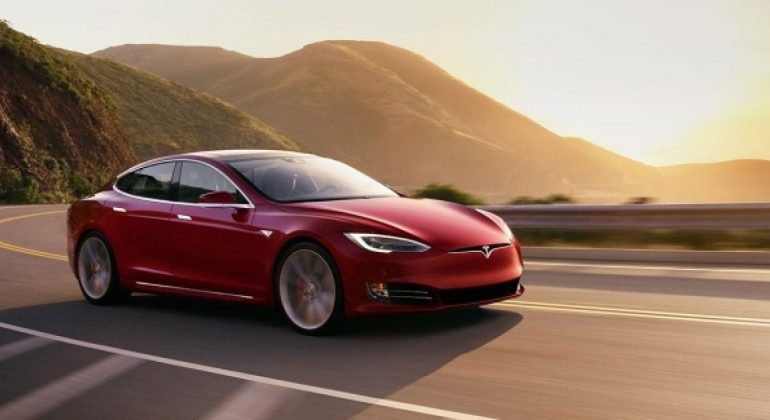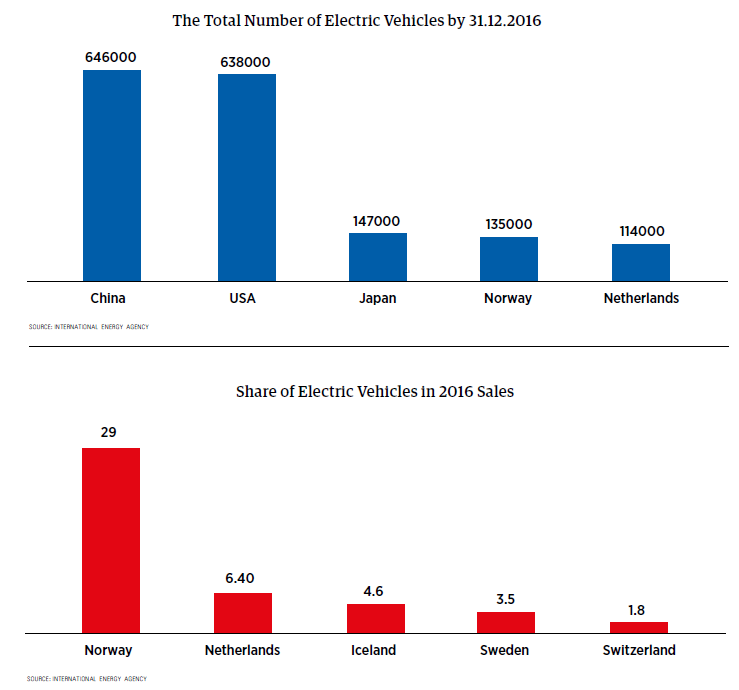There was a time when a chariot without a horse was simply unimaginable. However, Daimler and Benz made it all possible. At one time, only birds were heavier than objects that could fly. That is of course, until the Wright brothers managed to make the imaginary flying objects from centuries-old fairy tales and Da Vinci sketches come to life. Later, steam engines were replaced by diesel and electric locomotives, and today, battery-operated vehicles might become the precursor to self-driving cars.
The share of electric vehicles on the market is growing rapidly both in developed and emerging economies of the world. So, it’s no surprise that we come across an increasing number of studies and research on electric vehicles (EV) in various science and economic publications. This sudden growth in interest in electric vehicles is determined by a number of factors:
1) The price for an electric vehicle is gradually reaching the price of a motor vehicle of the same class.
2) The distance covered after one plug-in charge is increasing.
3) The infrastructure is improving and there is an increasing number of charging stations and service centers available for EV owners.
4) Governments in a number of states offer financial incentives, including tax credits, for lowering the up-front costs of electric vehicles.
5) People have become more concerned about the eco-system and the environment they live in and strive to improve it.
Despite widespread misconceptions, electric cars are not the product of modern technology. They are just as old as motor vehicles with their origin dating back as far as the late 19th century. La Jamais Contente was the first road vehicle to go over 100 kilometres per hour. It was a Belgian electricvehicle with a light alloy, torpedoshaped body, run on batteries. The vehicle was driven by the Belgian Camille Jenatzy who re ched the speed of 105.882 kilometres per hour. The share of electric vehicles before World War II was 1/3. Even in the best-case scenario, it would take at least 20 years to reach that global scale. The ‘big oil’ lobby is just one of the many reasons preventing the proliferation of electric vehicles.
Many oil company lobbyists have routinely scoffed at the growing share of electric cars on the market and have derisively referred to them as ‘coal-powered cars’. For many countries, this is not an entirely illogical assessment, since coal still remains the number one source for generating electric power – mostly because it is cheap. The current data indicates that the world’s oil reserves will last 40 more year and natural gas 50. However, the coal supply is expected to last at least 100 more years.
However, this supposition is not applicable with regard to Georgia, where the share of pure energy exceeds not just 20 percent but even 80 percent.
The share of thermal power plants will start decreasing in the near future, since Georgia is facing the prospect of building new HPPs. Wind turbines have proven to be very successful and Georgia has resources for solar power stations as well. Coal is only a small portion in the 19% share of thermal power stations in the country.
After their virtual absence for the last hundred years, electric vehicles made a comeback at the beginning of the 21st century. Elon Musk might not have been the first, but he definitely provided a boost and direction to many EV manufacturers. The demand for electric cars on the market exceeds supply nowadays. Car manufacturers were forced to seek additional financial resources to start building electric vehicles, or at least announce the launch in the production of EV in the near future.
Musk founded Tesla in the state of Delaware in 2003. In 2010, Tesla Motors launched its IPO on the NASDAQ exchange. The sales were very low at the time. In fact, the iconic Model-S, which was presented two years later, was not even on the market yet. The Model-S remains however, the best model among serial electric vehicles that are similar in scale to the S-class Mercedes (according to the design and comfortable driver and passenger seats). Among other cutting-edge technologies, the gem of the Model-S interior is the 17-inch touch screen, which is angled toward the driver and includes both day and night modes for better visibility without distraction. In addition, it places rich content at your fingertips and provides mobile connectivity so you can easily find your destination, favorite song or new restaurant. Most importantly, this car can cover 550 km with one full charge. The price of the Model-Sis in the $100,000 range – or to be more precise, the price ranges from $68,000–$158,000 depending on the various modifications, including battery power and added features. In total, 200,000 models have been sold to date. This figure is not huge, but if we take into account the price, the short history for the brand, as well as electric cars in general, it changes everything. If we look at the sales by country, we will see that 58% of the cars are sold in the US. Norway holds the second position at 7.7%, which can be explained by the country’s high purchasing power and generous government incentives. The Unites States and Norway are followed by China, the Netherlands, Canada, Germany, Great Britain, Switzerland and Denmark.
In 2015, Tesla introduced the Model-X Crossover. This vehicle also falls into the luxury car class. The price for this model ranges from $88,000 to $160,000. It offers ample seating of up to seven adults (including the driver). The Model-X also has wing doors that open vertically. Even though it cannot compete with the Hummer or other SUVs in its class, it can still go off-road and offers maximum comfort. One charge enables you to drive from up to 540 kilometers with a maximum speed is 210 km/hr.
Sales of this model have reached 60,000and 2017 quarterly sales are already coming close to the sales of the Model-S.
Due to its relatively low price, there was a lot of excitement and anticipation for the Tesla Model-3. The number of pre-orders for this model has already exceeded 400,000, which is more than all other electric cars ever sold by Tesla. The price for the Model 3 ranges from $35,000-$44,000 and the distance covered after one charge ranges from 350 to 500 km. The difference between the Model-S and the Model-3 in design, comfort and distance is far less than the difference in price between the two models. That is why customers were willing to pay an extra thousand dollars to reserve their cars. Nevertheless, the expectations that everyone had for this car were not quite met. No one has complained about the quality so far, but the supply has been delayed. A total of 367 Tesla Model-3s have been sold in the US through October of this year, which is significantly less that the anticipated figure. The Tesla Model-3 took only the ninth place by selling a mere 145 units in October. The company planned to manufacture 1,500 cars in q3, but all they could manage was 260 units, which is 17.3% of the planned figure.
Consequently, the company lost $671 million in the third quarter of 2017.In addition, the stock price fell by 7% and Elon Musk lost $800 million in just one night. Despite this trend, the manufacturer’s credibility remains intact. Anticipation among the general public remains high, as does the strong support of the government for this manufacturer. Notwithstanding his withdrawal from the Paris Climate Accord, US President Donald Trump did not revoke the incentives and various benefits that the US government offers the company. The reason behind Trump’s reluctance to cancel incentives is his wish to shift to eco-friendly transport, and of course the charismatic leader of the company. Musk’s ideas go way beyond conquering the electric vehicle market. In fact, Musk plans to colonize Mars and build a subsonic train Hyperloop.
Tesla is neither the first, nor the only company producing electric vehicles. However, it is entirely different from other manufacturers. The first thing that comes to mind when talking about electric cars is Tesla.
So, what makes Tesla so different from the others?
With other big market players like Nissan, Renault, BMW, Hyundai and Chevrolet, building and manufacturing electric cars is an additional line for them, while gas and diesel-operated vehicles are their main sources of income. The majority of car manufacturers have at least 50 years of history under their belts, and some have over 100 years. Compare this to Tesla, which is only 14 years-old.
In Tesla’s case, it was one of the first to begin manufacturing the serial production of longest distance electric cars. The company manufactures car batteries themselves, which is very costly. While Elon Musk is certainly not the Henry Ford of the 21st century, he may become just that in the future.
When talking about electric vehicles, we cannot avoid mentioning the Nissan Leaf, which was unveiled by the company in 2010. By 2014, the sales of this model enjoyed a 45% share on the EV market (a total of 275 models had been sold by 2016).
This car remains the sale leader but with fewer shares. Various modifications of this model cover from 120 to 200 km. The price for the leaf is in the range of $30,000. However, the price for pre-owned cars is far less, starting from $11,500 on www.myauto.ge.
There are approximately 1 billion cars in the world and out of this 1 billion only 2 million are electric cars. Indeed 0.2% is a small figure. However, just five years ago the number of electric cars didn’t even exceed 200,000. There would be more electric cars by now if the price for oil had not been falling so sharply since 2014. Just some five-years ago, most people in China had no idea about electric vehicles. Nowadays, China is leading by the total number of electric cars owned by the country. In addition to the fact that the ecological situation in China is deplorable, and that it remains a major environmental polluter, China does not produce oil. As such, by increasing the number of electric vehicles, it can decrease its energy dependency.
As the influence map gradually changes, Russia and the Arab states will be forced to give up their positions.
In terms of percentage, Norway is the indisputable leader. The other four countries in the top-five chart are also from Europe.
It is no coincidence that neither Germany, France and Great Britain were in the top five. These countries mostly buy cars from national manufacturers, while the most popular electric cars are Tesla and Nissan Leaf.
The state policy, as well as the price of excise and incentive taxes, has a major impact on the behavior of the potential buyer. Ireland is ahead of Norway in terms of per capita income, but it still did not get into the top-five countries. The number one oil-producing country in Europe holds the first position in terms of eco-friendly transportation, which can be explained by the state policy. The share of electric vehicles in Georgia is very small. That being said, Georgia has a very positive trend underway. According to information provided by the Ministry of Interior Affairs of Georgia, a total of 328 electric vehicles have been imported into the country from January through August 16 of 2017. This figure exceeds the total number of electric cars owned by the country before that date.
The customs tax for imported cars has increased significantly as of 1 January of 2017.However, there is no tax imposed on importing electric vehicles. Georgia also provides free charging stations. The country is also home to a growing number of imported hybrid vehicles. A total of 11,652 hybrid vehicles have been imported into the country in the first nine months of this year. The state has introduced a 60% discount on the customs tax associated with these imports. The share of hybrids in the total import of cars into the country has reached 25%, as opposed to the 5% in 2016. There is no need for a study in order to see the prevalence of Toyota Prius models in Tbilisi. In addition to the fact that the import tax for these cars has been greatly reduced, this car only consumes between 4-5 liters of gas to cover 100 km in the city, which is very economical.
Consumption of electric power by EVs depends on a number of factors, including the weight of the car, its aerodynamics, speed and the use of air-conditioning. On average, electric vehicles consume 15-20 kW h. The cost for electricity in Georgia on over 300 kW is 21.476 tetris (Telasi) and 21.45 tetris (Energo Pro). So the cost for 100 km is H3.2-4.3, which is ideal for the city. Even the most fuel-efficient cars consume at least 7 liters in the type of traffic jams the city is becoming infamous for. The price for the cheapest fuels in Georgia is 2.2 laris and the cost for 100 km is at least H15.4. The cost for electric vehicles when driving in the city is at least five times less, and four times less outside the city. The difference is price can only be compensated after covering at least 20-25,000 km, because after that, medium-sized electric vehicles can cover 100 km only at the rate of the price for 1.5 liters of premium-type fuel. For small sized electric vehicles, this would be less. In the case of electric scooters, the cost is 60 tetris per 100 km.
A number of countries are already developing future strategies. By 2030, the majority of European states will ban the production and import of ICE (Internal Combustion Engine) vehicles and by 2040, driving ICE vehicles in these countries will be banned. Some countries have gone even further and moved the deadlines closer.
For instance, Norway plans to impose a ban on ICE vehicles no later than 2025. This is the most radical statement so far, which will be hard to implement in view of the country’s population and the size of the economy. However, this plan is realistic. The Netherlands also plans to ban the sale of ICE vehicles by 2025. France and Britain have agreed to move the date to 2030. Germany has not decided yet, but it hopes that by 2020 there will be 1 million electric vehicles in the country. Germany has offered an incentive in the amount of €4,000 euros to everyone who buys an electric car. At the same time, Asia is not planning to stand aside. Toyota plans to start producing electric cars in 2020 that will be charged in just five minutes. China is announcing the sale of 7 million cars by 2025 and has already imposed compulsory quotas on the car manufacturers. India plans to sell 10 million electric vehicles by 2030.
Like in many other countries, there is a difference of opinion on this issue in Georgia. Below are the arguments of the opponents:
• Electric cars are bought by the wealthy and why should they be financed by the poor population that use public transportation.
• The price for electric cars is coming down as it is, so the state subsidies are just a waste of money.
• If we have agreed that subsidizing grapes, citruses and concert tickets is not acceptable, why should electric vehicles be subsidized? The supporters of EVs argue that:
• Air pollution is a reality that is affecting the health of the population;
• Treatment of sick people will cost the government more that subsidizing electric vehicles;
• Money spent on medical treatment will affect other sectors of economy;
• We will have less import and energy dependency on other countries; • 91% of the car pool in the country is old and these cars were manufactured more than 10 years ago, so why not renew the country’s transportation with eco-friendly vehicles.
Eco-friendly vehicles undoubtedly must enjoy certain incentives. However, a direct subsidy is not justifiable. We cannot compete with the Netherlands and Norway. Import tax is free, but registration of the car costs H180, which can easily be cancelled. Electric vehicles must be allowed to move freely on the so-called bus lines. We should accelerate the process of installing fast-charge stations throughout Georgia. The electric power that is consumed must be exempt from VAT, which will make travel even cheaper. The electricity rate must be decreased from 21.47 to 18.2 tetris.
The fuel import in Georgia in 2016 was 1.2 million tons and 1.6 billion liters. The bulk of this fuel is for vehicles. One liter of fuel equals 2 – 2.1 kW, which is at maximum 3.36 billion kWh. Georgia produced 11,574 kw/h electric power in 2016. Since then, then country has completed the construction of the Darial and Shuakhev HPPs. The construction of a number of other HPPs (Khudon, Namakhvan, Oni, Tskhenistkali and dozens of other smaller HPPs) is ongoing. 3.36 billion Kwh at the rate of 6 cents equals $200 million. The price for imported oil last year was $620 million, and the retail price was even higher. And no matter whether we look at this from the point of view of individual consumption, security of the country or the environment, electric vehicles are absolutely justifiable in Georgia. The main obstacle remains the low income of the population.
46% of the vehicles in the country were manufactured over 20 years ago. The price of these old vehicles ranges between $1,100 and $1,700, which is significantly less compared to the price for preowned hybrids and electric vehicles (minimum $4,500). But that is not the only problem. Unfortunately, many believe that driving a new black Prado or Mercedes is far more prestigious than driving around in a Tesla Model-S or Model-X.
The state can encourage the population by serving as an example itself and gradually replacing the state car pool and public busses with electric vehicles and electric buses. There are negotiations regarding the possibility to start manufacturing Chinese electric buses in Georgia, which is a very positive decision. Theoretically, there is a chance that Elon Musk may select Georgia for a Tesla Gigafactory 2, but this remains highly unlikely.
More information regarding this issue is needed and it seems that the most competent person to provide this information is President of the Georgian Automobile FederationS halva Obgaidze, a fervent supporter of electric vehicles and an MP of the newly assembled city council. Three of the cabs I stopped refused to take me from Akhmeteli metro station to Avchala, because they don’t know the route and there is no GPS in their cars. I am smiling at this, but definitely not from happiness. I found out that with the active involvement of Mr. Obgaidze, the government of Japan presented Georgia with five electric vehicles four years ago. Shalva Obgaidze himself owns a small Mitsubishi. His car used to cover 120-125 km, now he can only cover 105-110. The battery lifespan is decreasing just like the battery of a laptop or mobile phone battery. However, this is still more than enough for driving in the city. He has saved H20,000 over the last four years by saving on fuel and car parts. The consumption of electric power is in the region of H2. However, this cost increases when you drive uphill, increase speed or use air-conditioning. He remembers with a smile the surprised reaction of people to a noiseless car with zero emissions. I asked him about the future of the batteries and he told me that they are improving day-by-day. The size and price for the batteries is getting smaller, while the distance is becoming longer. Spain is experimenting with batteries produced with Nano-technology that are 50 times thinner than a printing paper. In addition to the eco-friendliness, Obgaidze believes that one of the major achievements of electric cars is that they led to the change of the general mindset. There is no sound when you turn the keys of an electric car, you don’t have to change the oil and filters. All of these taken together increase the security parameters of the vehicle. Parking is already free for electric vehicles in Tbilisi. Mr. Obgaidze completely shares my opinion to allow EVs to drive on bus lines. As a representative of the ruling party, Obgaidze promises that the government will replace the old buses with new eco-friendly buses, and quite possibly electric buses.
In addition to economy-class and business-class electric vehicles, some of the major car manufacturers around the world have started building luxury electric cars as well.
The Maybach Cabriolet is designed as an electric car. The drive system has an output of 550 kW (750 PS). The shallow under-floor battery allows a range of over 500 kilometers. And even if the battery is low, in just five minutes, enough power can be charged to achieve an additional range of around 100 kilometers. The car’s maximum speed is 250 km/h and even that is electronically restricted. In the case that you have an extra €500,000in your bank account, you can search for additional information on the Mercedes-Maybach 6 Cabriolet.
The forecasts are varying. The International Energy Agency believes that the total number of cars will double by 2040, while the number of electric vehicles will correspondingly increase 140 times. This is a very impressive forecast. However, the share of EVs will still be only 14%. This figure can change if the European states fulfill their commitments and China pursues the policy it has embarked on. At the same time, it is important to increase generation of power from natural sources. Even though the total share of electricity generated from wind and solar power is less than 3 percent, in 2001- 2016 the total volume of electricity generated from wind turbines has increased by 20.3 times (from 24 to 487 gigawatts). The generation of electricity from solar power has increased158 times (from 1.6 to 253). The technology of transforming solar power into electricity is certainly not a novelty. In fact, this technology is one year older than Edison’s light bulb (139 years-old).
When the world started to actively discuss global warming and environmental pollution, the share of carbon dioxide in the atmosphere was less than 350 parts, while 400 parts per million were regarded as an unsettling milestone. In July of 2017, this figure exceeded 407 ppm. This will definitely encouraged the green movement to increase its pressure on governments. The 2020s will prove to be crucial for the new industry. Elon Musk has already announced the comeback of his first electric vehicle by that date. The new Roadster would climb from 0 to 100 mph in 4.2 seconds (25% faster than Bugatti Chiron). Musk states that the Roadster will have a 200kWh battery pack and a 620-mile range per charge, or over 1,000 kilometers (but naturally not at this speed). The price for the new Roadster will range between $200,000 – $250,000, 12 times less than the price of the same Bugatti. Musk also promises that his 40-ton truck will be able to cover the range of 800 km. He is also making an effort to convince everyone that the maximum resource will be 1.6 million km. The price for the new electric truck is $150,000 – $180,000.
Walmart – the largest corporation in the world (with annual revenues exceeding $485 billion) and a major employer (2.3 million employees) has reserved 15 electric trucks from Tesla. All Volvo cars are to be electric or hybrid starting in 2019 – a landmark move as the first large manufacturer says it will stop making vehicles solely powered by internal combustion engine. BMW plans to replace the i3 with i5. At first glance, Mercedes-Benz seems to stand as an outlier with its few low-budget models, but that is not entirely true. This German car manufacturer has joined other car makers and will offer electric versions of every single car it makes by 2022. The Serial E-Class and Crossover will be entirely redesigned as electric vehicles.
Every new model of the Nissan Leaf is growing in size and range capabilities. The Hundai Ioniq looks like a regular sedan, but it is an electric vehicle with a range of 250 km. The price of this car is $30,000. Faraday plans to compete with Tesla on the US market. The company plans to launch production in 2019-2020. Jaguar and Porsche have also presented electric vehicles to their loyal customers. There are no restrictions whatsoever in design, speed, acceleration, and comfort of the interior. Even Rolls Royce, which was so reluctant to replace its panel with electric touch screen sensors, has succumbed to the new trend. For over 70 years the Soviet Union tried to catch up with the US in terms of per capita production, but it failed. However, electric vehicles have already gained on and will soon overtake all parameters of internal combustion engines. The major car maker Toyota has gone even further by building the new Toyota Mirai, which features hydrogen fuel cell technology. Just five minutes of charging time allows the driver to cover the distance of 650 km. However, this is a rather expensive car and even after the subsidies, the net cost remains as high as $62,000. Besides, hydrogen fuel stations are far less compared to electric power charging stations.
In addition to light passenger cars, the market is seeing a growing number of electric buses, trucks and other special construction machinery. Luxemburg purchased two Tesla electric cars for the police. One could easily notice the presence of unmanned vehicles in the framework of the Formula E Championship that launched in Beijing in September of 2014.
At the end of the day, the industry is changing, even though there might be some car makers out there who still believe that the roaring of the engine is what attracts drivers most. These are the ones that remain convinced that gasoline has no alternative. It’s important to note that it was not long ago that KODAK believed that people cared more about the film than the picture itself.



















